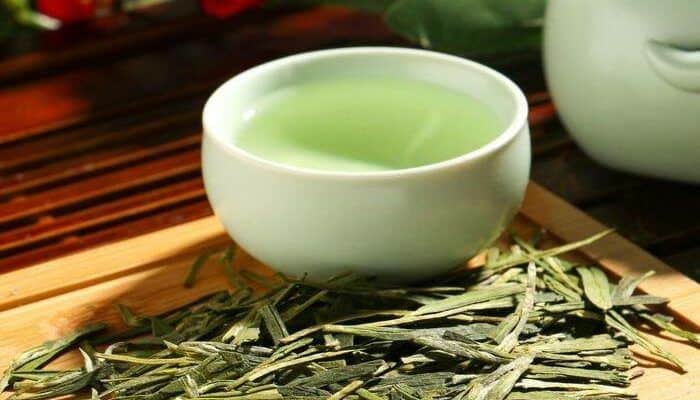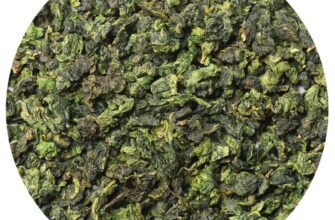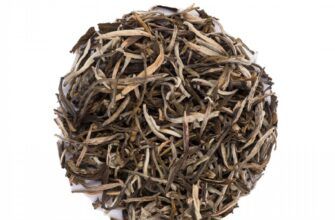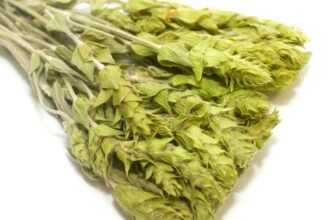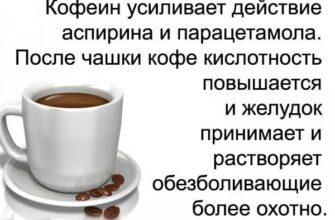The name of Longjing tea (translated as Dragon Key) can come from four sources: tea tree, key, temple, and spring. This tea came to us from the shores of the West Lake of Hanzhu, Zheilan Province, China.
Many years ago, this tea was highly valued for its absolute beauty: green color, elegant leaf shape, juicy taste, beautiful appearance. A delicate aroma lingers in the air for a long time, and a bright-colored decoction leaves a refreshing, bright, juicy and sweet aftertaste.
In order to make Longjing tea, this tea must go through intensive, manually controlled pan-roasting steps. On the baking sheet, the leaves are turned by hand using 10 different gestures, 10 different styles.
There are many varieties of this tea on the market, although the best tea is made in the place where it was prepared from the very beginning - the village of Longjing, which now integrates the historically returned areas of tea production. At present, now in Zheilan province, there are many manufacturers who make this tea. But due to different climates and different production methods, the quality of tea in these places is different. In addition, some parts of Zhe'an Province are urban areas, so there is a risk of heavy metal accumulation in tea leaves.
- History and culture of Longjing tea
- Longjing tea growing area
- Growing and Harvesting Longjing Tea
- Making Longjing tea
- drying out
- Tray drying - polyphenol inactivation
- Cooling
- Second frying - shaping and drying
- Longjing Tea Quality Criteria
- dried leaves
- Same color and size
- Purity
- Aroma
- Decoction color
- Taste
- Longjing tea leaves brewed
History and culture of Longjing tea
Longjing is a historical Chinese tea. The first mention of it dates back to 500 AD. It is said that the appearance of Longjing tea dates back to the early Song Dynasty and is written about in the very first Cha-Jin tea book. Once, it was named after the names of the mountains - Xian Lin Cha, Bai Yun Cha and Bao Yun Cha. Longjing was very popular during the Yan and Ming dynasties. The tea was named Longjing during the Song Dynasty. Also, this name was widely known during the Qin Dynasty.
It is said that during the Qing Dynasty, Emperor Qian-Long visited Mount Shi-Fen and was treated to Longjing tea. He was delighted with the taste of this tea and its beautiful appearance, as well as juicy taste. The monk showed him the tea garden. In which at that time there were only 18 tea trees. While the emperor was examining the tea trees, terrible news came - his mother fell ill.
The emperor had to urgently return home. All this time he kept the tea leaves in his pocket. He treated his mother to Longjing tea, and she was healed. The emperor was so grateful for this tea, and named 18 tea trees Imperial. Since that time, this tea has become an obligatory attribute of imperial ceremonies, and those 18 tea trees still grow on Mount Shi Fen.
Until today, Longjing tea is ranked first in the Top 10 Chinese teas. It has been chosen as the national tea and has always been chosen as a gift for foreign guests. Year after year, the glory of Longjing as the King of all teas does not fade.
Longjing tea growing area
The original Longjing tea comes from the Longjing village area, which is located on the shores of the West Lake. Historically, Longjing County has been divided into five districts and major tea-producing regions: Shi-Fen Mountain, Mei Zha Wu, Wen Cha Shan Mountain, Yang Xi County, and Hu Pao County.
Today, Longjing is classified into Shi tea, Mei tea, Xishu (meaning West Lake) tea, and Longjing from other places in Zheilan Province, which is called Zheilan Longzhin. The tea growing area is surrounded by fog all year round. One of the most important characteristics of this tea is its juicy taste. Theanine gives this taste to tea.
Young kidneys contain high amounts of theanine, but when exposed to sunlight, theanine is converted to the polyphenol catechin. In foggy areas, very little sunlight reaches the leaves, so the polyphenol in the leaves is retained.
In addition, mail in these regions has a poor water retention capacity, which is very important to maintain proper moisture. In addition, this soil has a high content of quartz, which provides the right pH for tea trees.
Growing and Harvesting Longjing Tea
The best growing variety is variety No. 43. Tea leaves of this variety have exceptional characteristics - dry tea leaves are flat, straight, with sharp tips and delicate green buds with a yellowish border. When this tea is brewed, it has a delicate and juicy taste. Bud formation is even, and all collected are almost the same size and color. This is the key to making the best quality tea. Moreover, every year variety number 43 starts bud formation 7-10 days earlier than other varieties.
Drinking the very first tea in early spring is something that tea connoisseurs love a lot. Therefore, the cultivation of this tea is a process beloved by farmers. Grade number 43 meets the stringent requirements of Chinese tea tasters and is considered one of the best teas to brew.
In early spring, buds with one or two leaves that are just beginning to open are picked by hand. The length of the kidney is 2.5 - 3 cm. The length of the kidney is an identifier for the “tenderness” of the tea.
Collection is done as early as possible. It is said that the best time to harvest tea is before the Ki Ming holiday (April 4 in leap years and 5 in the rest), the product is called Ming Kin Cha. The tea harvest before the Big Rain is called Yu-Kian Cha and is second in quality. In a day, even a very experienced picker can only collect 1-1.5 kg of tea. 0.5 kg contains about 60,000 buds and leaves. Leaves must be selected very carefully. The collection of tea is carried out so that all the buds and leaves are the same size and shape:
- Do not collect leaves with long stems
- You can not collect leaves and buds of purple color
- Do not collect tea buds and leaves damaged by disease
- You can not collect tiny kidneys that are attached to the kidneys
After collection, the leaves are placed in a cool room. On sunny days, they are laid in thin layers of 3-5 mm and left for 6-12 hours without turning or stirring, but if the leaves were collected after rain or dew, they are laid out in much thinner layers and mixed 2-3 times. At this time, up to 70% of water leaves the leaves. This process removes the herbal flavor and bitterness from the leaves. The concentration of polyphenol increases, which leads to a bright color of the decoction.
Making Longjing tea
drying out
After picking, the tea leaves are placed in a well-ventilated room in a layer of 3-5 mm for 6-12 hours to reduce the percentage of moisture by 70%. This robs the leaves of herbal flavor and increases the percentage of polyphenols.
Tray drying - polyphenol inactivation
During drying on a baking sheet, the main goal is to inactivate the polyphenol with heat, as well as to form a tea leaf. Using high temperatures, results can be achieved in a very short time. When the temperature reaches 80-100 degrees, you need to put about 100 grams of tea and roast it by hand. At the beginning, the main gesture is to take a handful of leaves, raise them to a height of about 10 cm and let them go slowly to gradually remove moisture. After toasting for 3-4 minutes, the leaves become soft.
After that, gestures change: turning, pressing, mixing. Leaves become flat and narrow. An experienced tea master must know exactly how much time is allotted for each gesture and how much effort to invest. Pressing too hard can result in a darker than desired color, and crooked and non-flat leaves indicate that the force was applied insufficiently or at the wrong time.
After 12-15 minutes, when the percentage of moisture decreases to 20-30 percent, you need to remove the leaves from the pan.
Cooling
Hot leaves are laid out in a layer of 15-10 cm and allowed to cool for 40-60 minutes. At this time, the leaves again absorb moisture and softness.
After cooling, the soft leaves are screened to remove small broken pieces, then sorted by hand to remove dark, burnt, yellow leaves and any foreign material. Also, the leaves are divided into three different baking sheets, depending on the degree of readiness and softness, to proceed with the second frying.
Second frying - shaping and drying
The purpose of the second drying is to shape and remove all moisture. Usually, 4-5 trays of tea from the first roast are processed together. The result is about 250 g in total. The baking sheet temperature is about 60-80 degrees Celsius. It is necessary to fry the leaves until they become soft again, and then again increase the temperature to 80-90 degrees and continue toasting. When all the leaves and buds have acquired the desired color and shape, you need to lower the temperature to 50 degrees Celsius.
During toasting, hand pressure also increases greatly. Gestures such as shuffle, tap, press are included. The fact is that the leaves should be in constant contact with the hands, but they should not be removed far from the baking sheet. This will bring the moisture level down to 5-6 percent, and takes about 25 minutes.
Longjing Tea Quality Criteria
dried leaves
The leaf is flat, shiny and straight, with a pointed tip. The tea leaf is about 2.5-3 cm long and is covered with a white film that is very hard to see and will dissolve during brewing. Lower quality tea has longer leaves, not as neat shape.
Color of tea leaves: yellowish green, even, bright and shiny. For lower quality teas, the leaf is not glossy, has a darker shade, and is mixed with leaves of varying quality. The overdried leaf has a grayish tint.
Same color and size
Good quality tea consists of identical tea leaves, the same size and color. Poor quality tea consists of fragments of leaves, leaves of different sizes. The leaves are of different colors, from yellowish to dark green.
Purity
Good tea does not contain foreign particles, bamboo or wood chips, sand or stone, dust.
Aroma
Good quality tea has a fresh, slightly herbal aroma, while poor quality tea has little to no flavor and is very hard to smell. The brewed tea has a fresh and long-lasting aroma. A good and strong smell suggests that the correct technique was used during the preparation of this tea. Good tea also has a slight nutty flavor. Poor quality product smells very strongly of grass, vegetables or peas. If the tea is overcooked, this will also be felt in the smell.
Decoction color
Bright, transparent, clean, delicate greenish color. For tea of lower quality - yellow or cloudy yellow.
Taste
The taste is bright, refreshing, but soft, juicy, has a sweet aftertaste. Poor quality tea has a bitter taste, slightly reminiscent of grass.
Longjing tea leaves brewed
Brewed tea leaves have a bright, fresh and uniform green color. The leaves are perfectly attached to the bud, like the petals of a flower. When touched with a finger, you can feel that the leaves are soft, but elastic. For low quality tea, the brewed leaves will consist of many broken pieces that are dark green or yellowish brown in color. Both buds and individual leaves are mixed. This indicates an incorrect collection technology - inexperience and inaccuracy in collection leads to premature oxidation of theanine.
Good quality tea also should not have a lot of holes or cracks in the leaves. If the tea leaf has been dried at too high a temperature or burnt, we may also observe cracks in the leaves and leaves separated from the bud. The real Longjing contains only buds and leaves attached to them like petals to a flower. The bud should be slightly larger than the leaves, and the leaves should be about 0.5-1 cm long. Poor quality tea consists of buds that are smaller than the leaves attached to them. Such leaves have an herbal smell, or almost no smell after several infusions.
Read more: